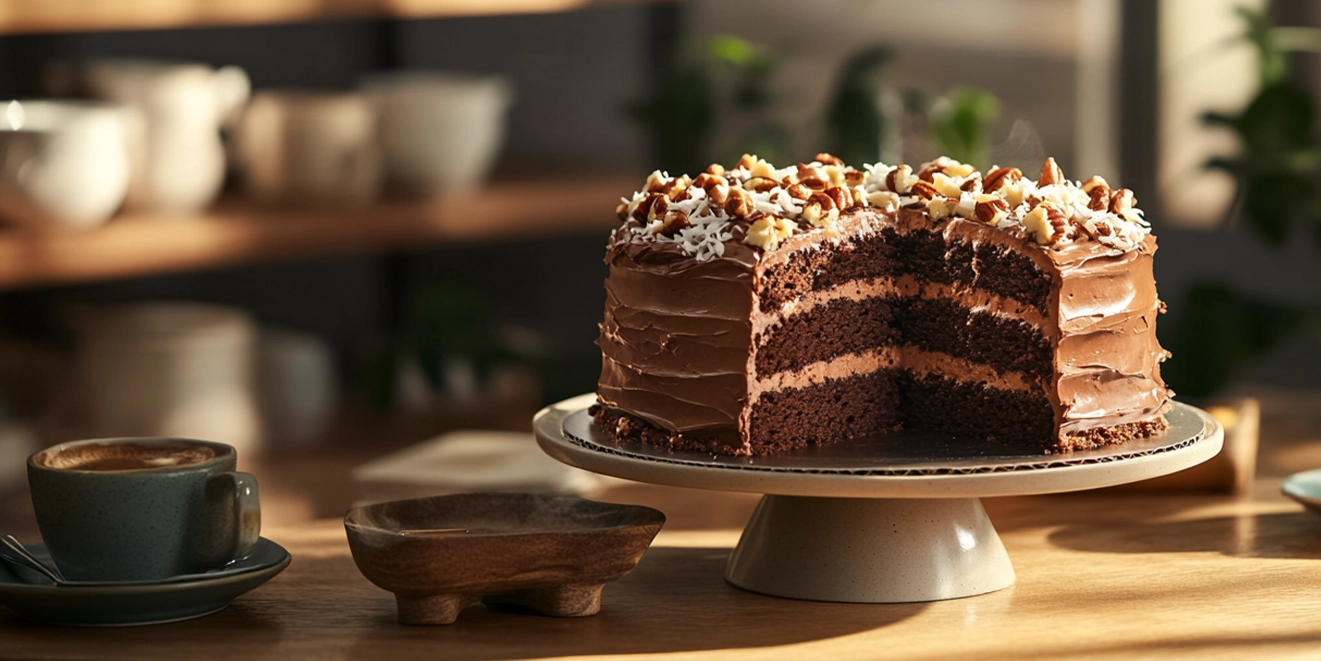
Table of Contents
Introduction to German Chocolate Cake
What Makes German Chocolate Cake Unique?
German Chocolate Cake is a rich and indulgent dessert known for its distinct layers of moist chocolate cake paired with a sweet, nutty coconut-pecan frosting. Despite its name, the cake does not originate from Germany. Instead, it was named after Samuel German, an American baker who developed a type of dark baking chocolate for the Baker’s Chocolate Company in 1852. The recipe gained popularity in the 1950s when it was published in a newspaper and has been a beloved dessert ever since.
Key Ingredients That Define Its Flavor
- German’s Sweet Chocolate: This unique chocolate has a mild, sweet flavor that gives the cake its signature taste.
- Buttermilk: Adds moisture and a slight tang, enhancing the cake’s richness.
- Coconut-Pecan Frosting: This frosting, made with evaporated milk, butter, sugar, egg yolks, shredded coconut, and chopped pecans, sets the cake apart from other chocolate cakes.
- Vanilla Extract: Complements the chocolate and frosting flavors for a well-rounded taste.
Essential Tools for Baking German Chocolate Cake
Must-Have Baking Tools and Equipment
- Mixing Bowls: These are used to combine wet and dry ingredients.
- Electric Mixer: Ensures the batter is smooth and well-aerated.
- Cake Pans: Three 9-inch round cake pans are typically used to create the traditional layered look.
- Spatula: Essential for spreading the frosting evenly.
- Measuring Cups and Spoons: These are used for accurate measurements of ingredients.
- Oven Thermometer: To ensure your oven maintains the correct temperature.
Optional Tools for an Enhanced Experience
- Cooling Racks: Allow cakes to cool evenly and prevent sogginess.
- Cake Leveler: Helps create flat, even layers for a professional finish.
- Parchment Paper: Makes it easier to remove cakes from pans without sticking.
- Offset Spatula: For smoother frosting application.
- Decorating Turntable: Facilitates easy and precise frosting and decorating.
Ingredients for German Chocolate Cake
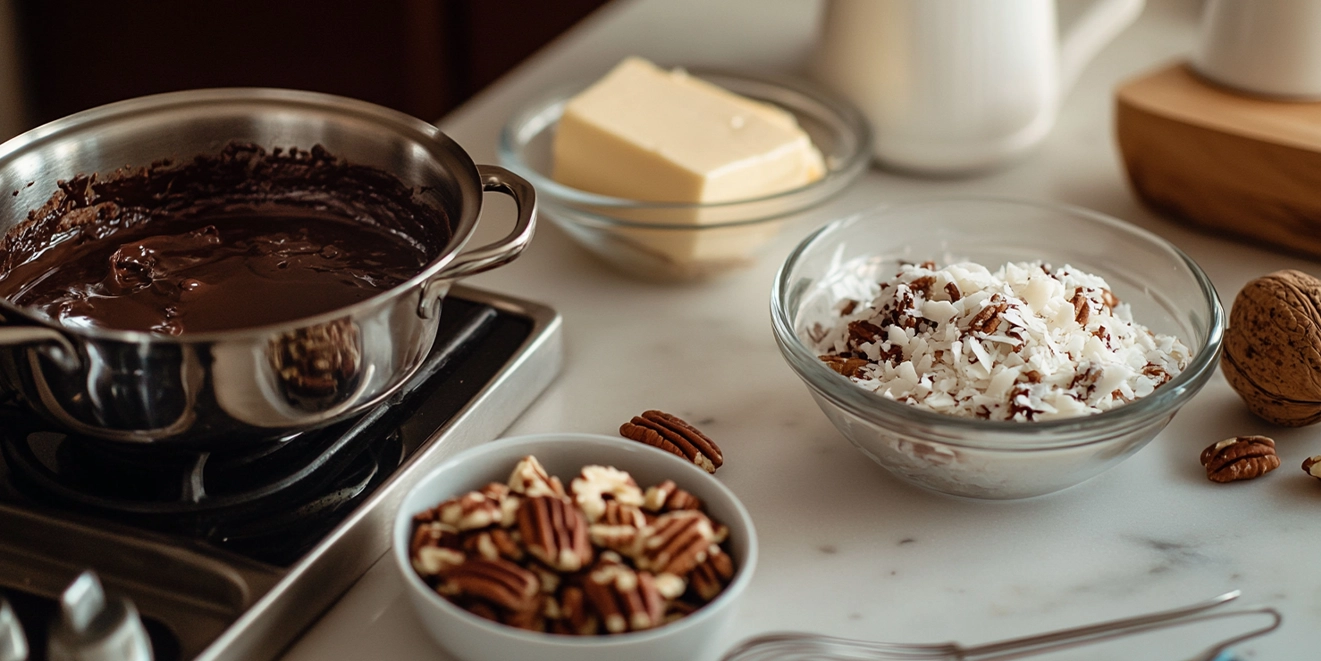
Cake Batter Ingredients
Here’s what you’ll need to create the rich and moist layers of this iconic cake:
- One package (4 oz.) German’s Sweet Chocolate: Melted and cooled slightly.
- 2 cups granulated sugar: For sweetness.
- 1 cup unsalted butter: Softened for a creamy texture.
- Four large eggs: At room temperature for structure and moisture.
- 2 ½ cups cake flour: Sifted for a tender crumb.
- One teaspoon baking soda: For leavening.
- ½ teaspoon salt: Enhances flavors.
- One cup buttermilk: Adds moisture and a slight tanginess.
- One teaspoon of vanilla extract: Balances the chocolate flavor.
Coconut-Pecan Frosting Ingredients
This frosting is the star of the cake, adding a unique, nutty, and caramelized sweetness.
- 1 cup evaporated milk: Creates a creamy base.
- 1 cup granulated sugar: Sweetens the frosting.
- Three large egg yolks: For richness and thickness.
- ½ cup unsalted butter: Adds creaminess.
- One teaspoon vanilla extract: Enhances the flavors.
- 1 ½ cups sweetened shredded coconut: For texture and flavor.
- 1 cup chopped pecans: Adds crunch and a nutty taste.
Optional Add-ins for a Twist
To personalize or enhance the classic German Chocolate Cake, consider these ideas:
- Espresso Powder: Add one teaspoon to the batter to intensify the chocolate flavor.
- Chocolate Chips: Fold ½ cup into the batter for added bursts of chocolate.
- Almond Extract: Replace half of the vanilla extract in the frosting for a nutty twist.
- Caramel Drizzle: Drizzle caramel sauce over the frosting for extra indulgence.
- Dark Chocolate Ganache: Spread a thin layer between the cake layers for added richness.
Step-by-Step Guide to Baking German Chocolate Cake
Preparing the Cake Batter
- Melt the Chocolate: Mix the German Sweet Chocolate in a heatproof bowl over simmering water or microwave in 30-second intervals. Set aside to cool.
- Cream Butter and Sugar: In a large mixing bowl, beat the softened butter and granulated sugar with an electric mixer until light and fluffy, about 3–4 minutes.
- Add Eggs: Mix well after each addition, one at a time. Stir in the melted chocolate and vanilla extract.
- Combine Dry Ingredients: In a separate bowl, whisk together the cake flour, baking soda, and salt.
- Alternate Dry and Wet Ingredients: Gradually add the dry ingredients to the wet mixture, alternating with the buttermilk. Start and end with the dry ingredients to prevent overmixing.
- Achieving Perfect Consistency: The batter should be smooth and slightly thick. Avoid overmixing to maintain a tender crumb.
Baking the Cake Layers
- Preheat the Oven: Set your oven to 350°F (175°C) and grease three 9-inch round cake pans. Line the bottoms with parchment paper for easy removal.
- Pour and Smooth Batter: Divide the batter evenly among the prepared pans, smoothing the tops with a spatula.
- Bake: Bake for 25–30 minutes or until a toothpick inserted in the center comes out clean.
- Cool Completely: Allow the cakes to cool in their pans for 10 minutes before transferring them to a wire rack. Let them cool completely before frosting.
Testing for Doneness
- Use a toothpick or cake tester in the center of each layer. The cakes are made if they come out clean or have a few crumbs.
- Lightly press the cake surface; it should spring back gently.
Making the Coconut-Pecan Frosting
- Cook the Base: In a medium saucepan, combine evaporated milk, sugar, egg yolks, and butter. Cook over medium heat, stirring constantly, until the mixture thickens (about 12–15 minutes). Do not boil, as this can curdle the eggs.
- Add Flavor and Texture: Remove from heat and stir in vanilla extract, shredded coconut, and chopped pecans. Mix well.
- Cool the Frosting: Allow the frosting to cool to room temperature. It will thicken further and become spreadable.
Common Mistakes and How to Avoid Them
- Curdled Frosting: Avoid high heat when cooking the base. Stir constantly and keep the temperature moderate.
- Runny Frosting: Cook the frosting until thickened. If it is too thin, return it to heat and cook for a few more minutes.
- Uneven Frosting Application: Let the frosting cool completely before spreading it to prevent sliding or dripping.
Assembling and Decorating the Cake
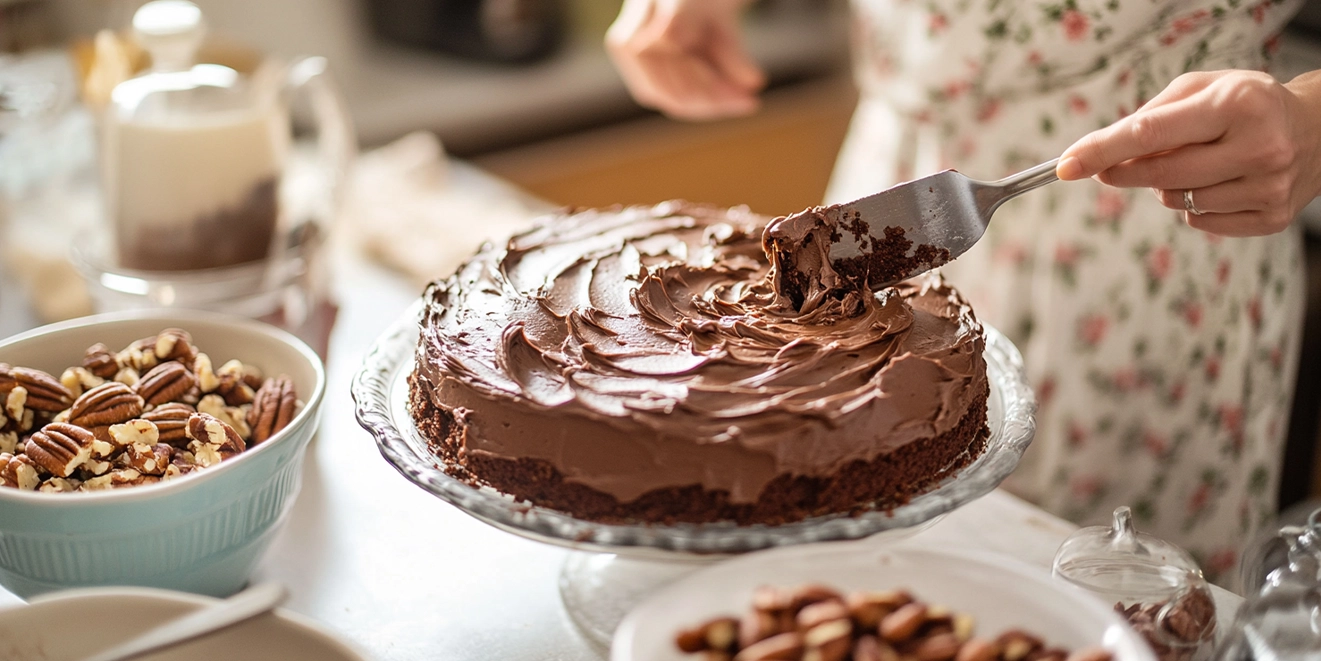
Layering the Cake
- Prepare the Layers: Ensure the cake layers are completely cooled to prevent the frosting from melting. If the layers are uneven, trim the tops with a cake leveler or serrated knife.
- Start with the First Layer: Place one cake layer on a serving plate or cake stand. Spread about ⅓ of the cooled coconut-pecan frosting evenly over the top.
- Add the Second Layer: Carefully position the second cake layer on top of the frosted one. Repeat the process, spreading another ⅓ of the frosting evenly over this layer.
- Top It Off: Place the final cake layer on top and spread the remaining frosting over it, focusing on the top and leaving the sides exposed for a traditional German Chocolate Cake look.
Tips for Stability and Structure
- Chill Between Layers: If your kitchen is warm, chill the cake in the refrigerator for 10–15 minutes after each frosting layer to help stabilize the structure.
- Use Dowels for Extra Support: If the cake is tall or if it is being transported, insert a few dowels or straws through it for added stability.
- Clean Edges: Use a spatula to tidy up any frosting that spills over the edges.
Final Touches and Presentation
- Decorating the Top:
- Chocolate Shavings: Sprinkle dark or milk chocolate shavings over the frosting for added elegance.
- Toasted Coconut and Pecans: For extra texture and decoration, add a light sprinkle of toasted shredded coconut or pecan halves.
- Caramel Drizzle: Drizzle caramel sauce over the top for a luxurious touch.
- Sides of the Cake:
- Rustic Look: Leave the sides unfrosted to showcase the layers.
- Fully Frosted Option: If you prefer a smoother finish, use a thin layer of buttercream or additional frosting to cover the sides.
Serving Suggestions
- Slice and Serve: Use a sharp knife to cut clean slices, wiping the blade between cuts for a neat presentation.
- Pairings: Serve with a dollop of whipped cream or a scoop of vanilla ice cream for added indulgence.
- Occasion Styling: For a restaurant-quality presentation, garnish each plate with a mint sprig or a dusting of cocoa powder.
Tips and Tricks for the Perfect German Chocolate Cake
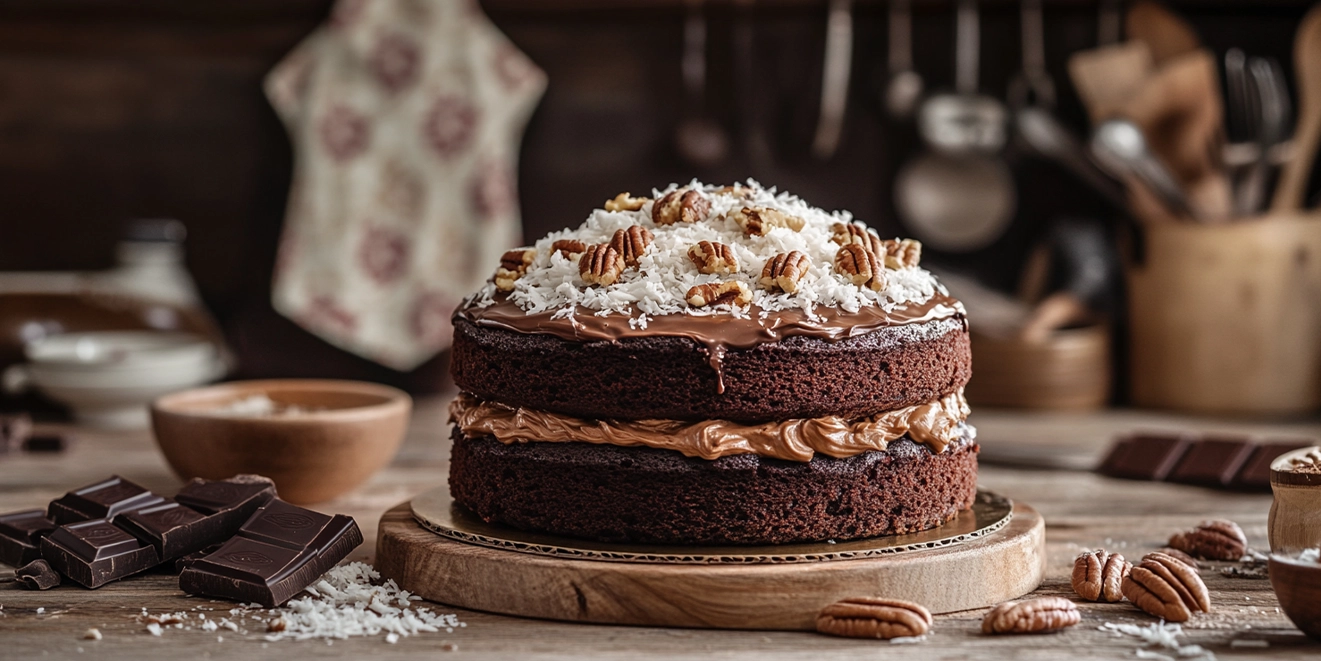
Common Baking Mistakes to Avoid
How to Fix or Prevent Dry Cake
- Measure Ingredients Accurately: Use the spoon-and-level method for measuring flour to avoid packing too much into the measuring cup, which can result in a dry cake.
- Don’t Overmix the Batter: Overmixing can overdevelop the gluten in the flour, leading to a dense and dry texture.
- Check Baking Time: Watch the cake closely as it bakes. Overbaking will dry out the layers. Begin checking for doneness a few minutes before the suggested baking time.
- Use Buttermilk: The acidity in buttermilk adds moisture and tenderizes the cake.
- Cool Properly: Allow the cake to cool in the pans for 10 minutes before transferring to a wire rack. Cooling too quickly or unevenly can affect the texture.
Frosting Tips for a Smooth Finish
- Simmer Frosting: Avoid rushing the cooking process. Use medium heat and stir constantly to prevent lumps or curdling.
- Cool Completely Before Spreading: Let the frosting reach room temperature so it thickens properly. Spreading warm frosting can cause it to slide off the cake.
- Use an Offset Spatula: This tool allows for smoother and more even frosting applications.
- Layer Frosting Evenly: For a professional look, ensure each layer has an even amount of frosting. Use a piping bag to outline the edge of each layer before filling in the center.
Storing and Freezing German Chocolate Cake
Best Practices for Maintaining Freshness
- Short-Term Storage:
- Cover the cake tightly with plastic wrap or store it in an airtight container.
- You can keep it at room temperature for up to 2 days or refrigerate it for up to 5 days. If refrigerating, bring it to room temperature before serving to enhance flavor and texture.
- Freezing the Cake:
- Unfrosted Layers: Wrap each cooled cake layer tightly in plastic wrap and aluminum foil. Store in a freezer-safe bag or container for up to 3 months.
- Frosted Cake: Place the frosted cake in the freezer for about one hour to harden the frosting, then wrap it tightly in plastic wrap and aluminum foil. Freeze for up to 2 months.
- Thawing Instructions:
- For unfrosted layers, remove them from the freezer and let them thaw at room temperature while still wrapped to prevent condensation.
- For a frosted cake, unwrap it carefully and let it thaw in the refrigerator for several hours or overnight.
FAQs About German Chocolate Cake Recipe
What Makes a German Chocolate Cake Different?
German Chocolate Cake stands out due to its signature coconut-pecan frosting, which is caramel-like and rich, unlike traditional buttercream or whipped frostings. It also uses German Sweet Chocolate, which is milder and sweeter than regular dark chocolate, giving the cake its unique flavor. The layers are moist and tender and perfectly complement the nutty, coconut-infused frosting.
What Are the Ingredients for a German Chocolate Cake?
The key ingredients for the cake and frosting include:
For the Cake:
- German’s Sweet Chocolate
- Granulated sugar
- Butter
- Eggs
- Buttermilk
- Cake flour
- Baking soda
- Vanilla extract
For the Coconut-Pecan Frosting:
- Evaporated milk
- Granulated sugar
- Egg yolks
- Butter
- Shredded sweetened coconut
- Chopped pecans
- Vanilla extract
Why Does German Chocolate Cake Have Coconut?
The coconut-pecan frosting is a defining element of German chocolate cake. This frosting provides a unique texture and flavor that contrasts beautifully with the chocolate layers. Including coconut and pecans adds a chewy, nutty sweetness that has become synonymous with the dessert.
Why Does My German Chocolate Cake Fall?
A German Chocolate Cake can fall for several reasons:
- Overmixing the Batter: Overmixing incorporates too much air, which can cause the cake to rise rapidly and then collapse.
- Incorrect Oven Temperature: An oven that’s too hot or too cool can affect how the cake rises. Always use an oven thermometer to ensure accuracy.
- Underbaking: If the cake isn’t fully baked, the center may sink as it cools. Check for doneness with a toothpick or cake tester.
- Opening the Oven Door Too Early: Sudden temperature changes can cause the cake to deflate. Avoid opening the oven door during the first 20 minutes of baking.
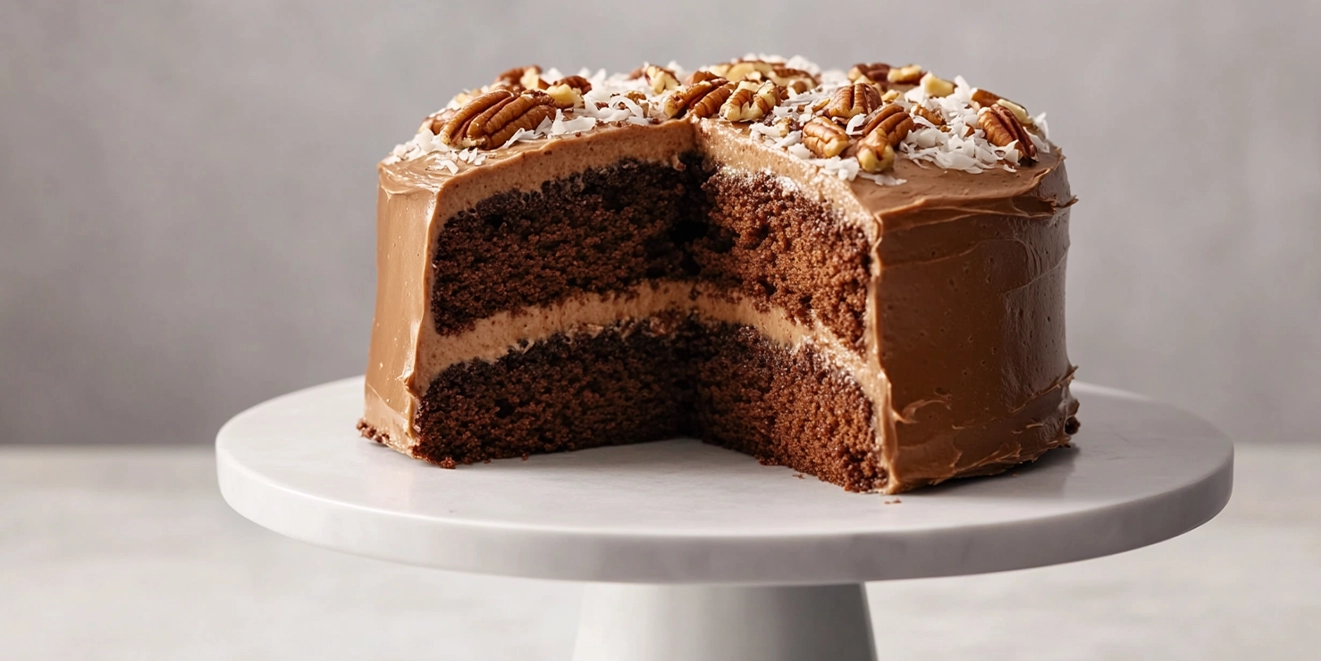
Conclusion
German Chocolate Cake is a timeless dessert that combines rich chocolate layers with the unique, nutty sweetness of coconut-pecan frosting. Its history, distinct ingredients, and intricate yet rewarding preparation process make it a favorite for special occasions and family gatherings. With the right tools, techniques, and tips, you can create a show-stopping cake that’s as delicious as beautiful.
Whether you stick to the classic recipe or add your creative twist, this cake will impress your guests and leave them craving more. Happy baking, and enjoy every bite of your homemade masterpiece!
- For tips on baking techniques, refer to “How to Make a Homemade Funnel Cake.” This guide shares excellent insights into achieving the perfect batter consistency, which is also applicable to cakes.
- For more dessert ideas, check out the “Dirt Cake Recipe,” a no-bake treat that pairs wonderfully with other chocolate-based desserts.
- Are you looking for a quick, sweet fix? Try Rice Krispie Treats for a simple and delightful dessert idea.
- Enhance your chocolate game by learning about “The Ultimate Guide to Making Baked Beans Recipe,” which discusses” flavor layering techniques.
